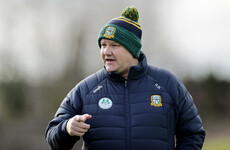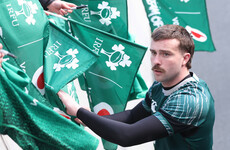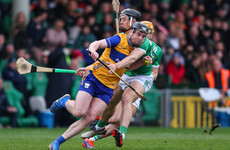INJURY, RUGBY PLAYERS constantly tell us, is just part and parcel of the game.
While those of us on the outside peering in feel some kind of vicarious gut-wrench whenever a talented athlete pulls up or gets knocked down, those involved usually insist they take every blow on the chin and march forth.
It’s not a question of if, but when. As if there is a some fine print in their contract guaranteeing a lengthy lay-off through an excruciating affliction at some point.
However, even the most stoic of hardened pros feel the emotional pang when such an injury arrives in the weeks or months approaching a World Cup.
The warm-up fixtures ahead of the quadrennial tournament are the closest thing international rugby offers to the ‘friendly’ status some wish to attribute to Test matches. As low as the octane can get in the late summer outings, though, they do not save World Cup hopefuls from the cruel twists of fate and ankles. Taulupe Faletau hasn’t even made it as far as matchday.
When a player hits the ground at this time of year, at this time of the cycle, there is a sickening feeling that drills to the pit of the stomach. Yet it is what is is, as they say, and rugby players know that Sword of Damocles has two edges. Injury means opportunity for the men battling their way up the pecking orders for positions and comfortable airplane sleep pods.
Reaping benefits from somebody else’s misfortune is part of the game. And it has been an inescapable factor in World Cup build-ups. Bolters don’t always emerge by form alone.
Geordan Murphy’s 2003 heartbreak stands out as an archetype of pre-World Cup injury. Before Eddie O’Sullivan’s side had gotten sick of winning Triple Crowns, Murphy was in the same breath as Brian O’Driscoll and Ronan O’Gara as the catalysts for Ireland’s exciting back-line. So the sight of him lying stricken in Murrayfield with a compound tibia fracture brought lamentations from far beyond Irish shores.
Girvan Dempsey delivered a ready-made option to step in and shore up the 15 role. But when the squad was announced for Australia Anthony Horgan appeared to be the man who benefitted most from the Leicester stalwart’s absence. Horgan only made his Test debut earlier that summer in the off-Broadway tour of the Pacific. He had three caps to his name before the squad set off to Australia, and unfortunately still had three when the team headed home after a quarter-final exit to France. He won his fourth cap against Les Bleus the following February.
Those who believe in Karmic compensation might draw a few more lines from Ireland’s fullback jersey around this time. Dempsey’s 2003 promotion to a starting role came four years after he was forced to pull out of Warren Gatland’s 1999 squad injured. Gatland’s time on these shores was hallmarked by injections of youth in teams and so Gordon D’Arcy was brought into the fold alongside Brian O’Driscoll and featured in the pool win over Romania on Lansdowne Road.
Though the swings and roundabouts didn’t go Murphy’s way in 2007 – or for anyone else, really – approaching the World Cup for a third time, a slice of luck finally fell his way. A slice chipped right off Felix Jones.
The former Munster coach was one of a handful of exciting young talent pushing hard for places in Declan Kidney’s touring party to New Zealand. While results were not going Ireland’s way in warm-up Tests against France there was enough energy and invention in their performances to hint at the excellent pool campaign ahead. Jones’ intelligent kicking and counter-attack game was a big part of that.
2011 felt particularly punitive. A home defeat to England at the Aviva left David Wallace laid low by a knee ligament injury that ended his match after 22 minutes and his international career at age 35. In his place, Shane Jennings travelled as Sean O’Brien’s understudy and the veteran managed to start the opener against the USA and get on the scoresheet against Russia as Ireland topped their pool for the very first time.
On the way to that feat, Australia were accounted for in a powerful performance on a slippery Auckland night. It was a bite and bollock display for the ages that was almost adorned by a cherry of a try from one of the truly great bolters.
Victory was already secured when Conor Murray delightfully stepped Pat McCabe in the right-hand corner and threw himself over the line to lift the roof off the Auckland stadium. Unfortunately, the try was chalked off for a breakdown penalty, but Murray’s rise already felt irrepressible.
At 22, the Patrickswell man was vying with Tomas O’Leary over third and fourth choice in the pecking order for Ireland’s number nine jersey. Two years on from the Grand Slam and a sickening broken ankle denied him a Lions tour, O’Leary struggled to rediscover to find his form and so the young upstart under a black mop of hair went to New Zealand to complement Eoin Reddan and Isaac Boss. He took over as first-choice scrum-half in the pool-closing win over Italy in Dunedin. Eight years on, he still holds the jersey.
The Joe Schmidt era didn’t save us from pre-World Cup injury woe either. Tadhg Furlong’s rapid rise to becoming the world’s best tighthead may have been slightly delayed had Marty Moore not succumbed to injury in 2015 after featuring in 10 consecutive Six Nations matches.
That set of World Cup warm-ups delivered one of this century’s most harrowing injuries for an Irish player. Tommy O’Donnell was hitting serious form on the first day out of the traps, but with five minutes remaining under the roof in Cardiff, the Tipperary man was left stricken on the turf by a dislocated hip.
In his place, the bolter took the form of an experienced head once more as Chris Henry returned to the international scene for the first time since a ‘mini-stroke’ the morning of a Test against South Africa ended his run of seven straight starts as Ireland’s openside.
Henry ended up featuring in all five of Ireland’s outings at the tournament and owing to a suspension for O’Brien, then started the quarter-final against Argentina in Cardiff.
Ireland coaches, players and fans alike will hope to avoid such dramatic swings and roundabouts that injury brings at this time of the World Cup cycle.
That hope will be in vain, and we will see some eager hopeful chomping at the bit as he runs past a laden-down stretcher and into action.














Why is the English women’s league pushed so much on these shores, no one is interested, there’s never a reply to any of the stories reported.
Radio stations, notably offtheball cover it more than the mens league here, it’s really strange.